Burundanga – it’s bad and it’s back

In Colombia you’ll hear about scopolamine, AKA burundanga , “Devil’s Breath” or “borrachero”. And perhaps you think these druggings only happen to sex tourists. But anyone can fall victim, including local people, seasoned travellers and expats settled in Colombia. You can be ‘scoped’ in a park, in a café, in the street, or on a bus, or even during a Spanish lesson.
On the other had around 5 million tourists and visitors come to Colombia every year, and only a very small handful get drugged or robbed. Most have a safe trip. Stay in that majority. Here’s what you need to know.

Posted in June 2023. See related posts Killed in the Darien Gap and Is Colombia Safe?.
Burundanga and other druggings: an overview
This is a long post, so here’s some key points.
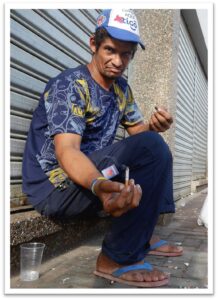
- Reported druggings are on the rise and linked to an increase in sex tourism.
- Most on-line drugging stories are by foreign males drugged by Colombian females
- Colombians are also victims, but their stories less heard.
- Ditto female victims are less likely to report, denounce or publicize their experience.
- Druggings can be minor events, catastrophic, lead to medical problems. Or death.
- Drugging is an ancient art (from the dawn of history) and practiced worldwide.
- Burundanga refers to plant-based scopolamine processed into a white powder.
- Many other pharma drugs are used such as benzos (clonazepam, diazepam etc).
- Drugs can be mixed to make victims easier to handle. Victims can be drunk or high.
- Most drugging is by professional crime gangs. Small teams of amateurs also take part.
- Most victims are robbed, but drugging can be used for sexual violence or other ends.
- Scopolamine prevents the brain from storing memories. Victims lose hours or days.
- Victims can become auto-suggestive and collaborate in their own robbery.
- Because of memory loss, many victims struggle to recognize they were drugged.
- Scopolamine leaves very little biochemical traces and is practically impossible to detect.
- Colombian authorities rarely investigate incidents (unless the victim dies).
- There are ways to practical ways to reduce your risk and recover from an attack.
Still with me? Please read on….
A bad night in a Lima bar
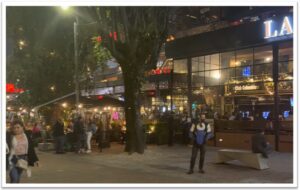
I discovered burundanga the hard way 25 years ago after being drugged myself in The Piano Bar in Lima, Peru, celebrating a birthday among backpackers and some young Peruvians who befriended us. My reaction was typical of a high level of scopolamine ingestion: delirium, hyperactivity, hyper aggression, then complete memory loss.
When I awoke 24 hours later, covered in bruises, my only reference point for the lost evening was my friends’ testimony to some crazed hours in which I had started a bar fight, swung wild punches, got punched in return, smashed glasses and furniture, and was restrained by five people who got me in a taxi where I then proceeded to battle the driver for the steering wheel, even while sat on in the back seat.
All I had for evidence of this event – apart from the shocked reactions of my co-travellers – was a lot of bruises.
I didn’t even suspect drugging until a few days later when I met two other backpackers who had been drinking in the same bar, passed out, then woke up robbed in an alleyway on the other side of the city. I felt lucky just having been beaten up. Perhaps the Peruvians who drugged me were simply practicing the dosage.
“Give me more on the poisoned nipples”

After my Lima incident, I started recording stories from travellers along the Andean trails, and then researching drugging events in other tourist hotspots such as Thailand. This led to a long article for the UK’s Daily Telegraph in 2000. The editor seemed to like it: he messaged me to say “send more copy on the poisoned nipples”.
That related to the deaths of 45 middle-aged European sex tourists in the Thai resort of Pattaya over a period of 9 months in the late 1990s, accidentally poisoned by Thai sex workers who smeared too much knock-out lotion on their breasts.
The police investigation into the Poison Nipple Gang – as it became known – was hampered by the fact that the victims, even before meeting their deadly dates, had already dosed their own bodies with alcohol, amphetamines, and Viagra. The toxic tit was just the tipping point.
Because of the stigma, families back home were reluctant to push authorities to uncover what their male relatives were really up to before the “heart attack” during an all-male “culture tour” of Southeast Asia.
So, what’s changed?
Roll forward 23 years to Colombia and many drugging cases – and deaths – are still linked to sex, or some naïve hope of romance, with usually male victims meeting their female drugger (or ‘druggers’, since most work in pairs) on dating apps like Tinder, Grindr, Bumble and Colombia Cupid, or in bars and restaurants.
Out of 27 violent deaths of foreigners in Medellin in 2022, at least four were linked to drugging and several others are suspect. Add dozens of reported drugging and robbing and probably hundreds more unreported cases.
Of course, it can also happen in Bogotá, Cali, Cartagena or Barranquilla. But Medellin seems to be the epicenter with its large influx of visitors, expats, sex tourists and retirees, mostly with more money than the locals, and organized crime gangs increasingly targeting visitors.
The main difference today is that some victims (usually men) are more likely to publicize their misadventures. In Medellin the phrase is “getting scoped” or simply “got”.
Victim or aggressor?

Throughout this post the ´victim´ is the person drugged, and the ´aggressor’ is the person drugging. But by some measures some ‘aggressors’ are also victims, by this I mean the mostly very young females recruited to seduce their targets and deliver the knock-out drug.
As much as we like the image of the self-empowered femme fatal, the real story is that these chicas working the gringo bars are part of a sprawling and deadly criminal empire. They are subject to coercion, exploitation and abuse, are frequently underage, often vulnerable migrants (trafficked from Venezuela), and at the bottom of the underworld hierarchy under death threats from the gang boss (usually male) and gang enforcers who are rarely brought to book.
Sex tourism creates a toxic world where battle lines are drawn. “Gringos abuse us, we drug them” is one comment from a female drugger interviewed on-line.
And overseas tourists can become perps, or highly suspect, as in the recent case of a Texan man who fled the country after a popular Colombian DJ Valentina Trespalacios was found dead and stuffed in his suitcase. And a teacher who was recently tried and jailed in Texas for children abuse in Colombia, one of several cases before the US courts of citizens engaging in sex with minors while overseas.
Of course, we can’t blame drugging victims either; many were simply enjoying a night out or looking for friends. Remember too that sex work is technically legal in parts of Colombia, even if closely tied to exploitation by criminal gangs. Vulnerable too are people using dating apps like Tinder: factors like poverty and gender power imbalances make on-line hookups a different deal from New York, London or Paris.
You may get lucky. Or you might get scoped…

Some recent drugging events…
Youtube is bursting with “I was drugged in Colombia” or, more usually, Medellin. The testimonies appear sensationalist but are often a good reflection on what happened with lessons to be learned. Here is a synopsis of recently reported attacks, and the links to follow up.
Tobias The Traveller has an account of how he was drugged with clozapine by two women in his Medellin apartment, but in the end was robbed by the police who came to assist him.
Seasoned 54-year-old traveller Eric Hall was drugged with scopolamine and held for three days against his will.
Musician Kevin McCaffrey – who had lived and worked in Colombia for 11 years – was drugged in the street by a female date in Cartagena and lost US$15,000 from his bank account.
Another cautionary tale is from Lost With A Beer, a UK visitor drugged by a female in his apartment with film of him in a drugged state.
Vlogger Quis recounts a failed drugging attempt by a female who rubbed scopolamine lotion rubbed in his lip in a bar in Medellin.
For inside knowledge on how drugging gangs work, check out DC Born Rob with his “Paisa Interview” on how females work in pairs to drug victims carry fake IDs, are part of a complex criminal network including taxi and Uber drivers, bar owners, restaurants and an analysis of a police take-down of a Medellin drugging gang last year.
Then Youtube channel Obi Laand has some amazing documentaries with interviews with drug gang leaders such as The Scopolamine King (will look closer at this later) and a woman who drugs her tourist dates, and a sting operation set up by expats to catch their own druggers.
And while you’re down the burundanga rabbit-hole, don’t overlook Vice who did a 2012 documentary Devil’s Breath: the World’s Scariest Drug.
How big is the drugging risk?
How real is it? Difficult to say since Internet click-bait is hardly a good measure of actual drugging cases. Hard data is hard to find. The Overseas Security Advisory Council (OSAC) estimates the number of “annual scopolamine incidents in Colombia at approximately 50,000.”
Myself, I’ve met dozens of victims over the years including several females who had very scary experiences – “I woke up with a strange man in a strange hotel room having lost three days of memory” – and travellers who drugged far from the fleshpots of Medellin, such as the backpacker drugged by an old lady on a bus to Popayan (he came to in a hospital bed in Cali with no belongings four days later).
Any causal inquiry among expat friends usually brings the response, “oh yes, that happened to me once”. Meanwhile medical friends recount that Colombian cities’ emergency clinics regularly fill up on Saturday nights with local drugging victims; so many that the expensive diagnostic tests are rarely done, and police not always interested since evidence is scarce.
Embassy on alert
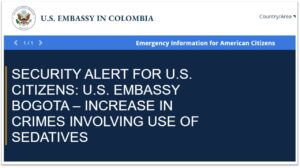
According to local news media, at least 40 drugging cases were officially reported in Medellin in the first three months of 2023. More historic data, from 2007, from Medecina Legal gives official figures of 18,000 cases of drugging related sexual abuse in just that year alone.
And an article in March 2019, in El Colombiano, states that during a period of three years from 2016 to 2018, 602 people were reported drugged and robbed in Medellin. And 208 of these cases were in 2018. Note that not all these cases were scopolamine, as other drugs such as benzodiazepine and phenothiazine are also used.
Drugging kingpin Cobra, interviewed by Obi Laand Youtube channel, claims to run team of around 30 female druggers in Cali, Medellin and Cartagena and net around US$10,000 a night. Based on this data we can estimate 10 victims a night across three cities, which adds up to 3,000 victims a year just from one gang (and there are many more).
In June 2023, the US Embassy issued a security alert for citizens visiting Colombia of increased drugging cases with ‘foreigners routinely targeted through online dating applications or in bars and nightclubs’ mostly in Medellin, Cartagena, and Bogota. ‘Some of these incidents have resulted in victims dying or needing serious medical assistance as a result of an overdose from the drugs used to incapacitate the victim’.
Deadly druggings
Deaths, particularly of foreigners, are more likely to be investigated and often culprits captured. Recent cases include:
- a Canadian professor, Dr. Ramazan Gencay, kidnapped and killed by an overdose of Benzodiazepine by a Tinder date in Medellin in 2018.
- In 2022, California resident Paul Nguyen, 27, was honey-trapped by Tinder, date called Maria who drugged him with another “benzo”, clonazepam. The gang members were captured after Paul sent a Snapchat photo of Maria to friends before succumbing.
- In March this year a Colombian priest was found dead with suspected poisoning after heavy drinking in a bar in Medellin, though no toxins were ever identified.
- Richard Evans Clark, an expat living in Medellin, died in 2022 after inviting two females to his apartment for some drinks and an oily massage which police suspect was how they overdosed him before stealing valuables and credit cards.
- Yudith Anaya died of cerebral hypoxia after being drugged in Bogotá by a gang called the ‘Los Tomaseros’ working upscale bars in the north of the city.
- In May this year, two men were found by a roadside, one dead and one alive, after being drugged in Manizales.
- In the UK, in 2019, two criminals used burundanga was used to kill and rob a champion Irish dancer, and rob another victim.
- Hernan Mejia, 39, a Bogotá resident, drugged and kidnapped from a restaurant in the north then found dead in the southside several days later.
In the same month as Hernan Mejia died in Bogotá, several other students were drugged in bars and found alive but disoriented in poor barrios, a 17-year-old girl was drugged and sexually assaulted in a taxi, and another youth drugged in public on a Transmilenio bus.
The covid pandemic gave rise to some new ways to deliver the drugs: through “anti-bacterial sprays”, in at least case used by a taxi driver to incapacitate and rob his passenger.
Other high-profile cases:
- Two U.S. soldiers were drugged, kidnapped and robbed by the same Tomaseros in 2020 at a posh sports bar in Colombia. A suspect was recently extradited to face court in the U.S., and possible life imprisonment.
- Two US marines were disciplined and a marine colonel sacked after losing classified documents, laptops and cellphones after bringing sex workers back to their hotel rooms in Bogotá in 2017.
- Three diplomats from the Moroccan embassy in Colombia were drugged and robbed by two sex workers in Bogota in 2022.
Other cases that made international news include the horrific case from some years ago of a pregnant women drugged then awaking to find her baby cut from her womb. In a case going back to the 1990s, two women, angry at a man flirting with them, drugged him and cut off his penis.
In a less sensational case, a Northern Ireland man living and working in Bogotá was drugged while taking coffee in a local café, then lead back to his apartment by the attackers that then cleared it out of his valuables.
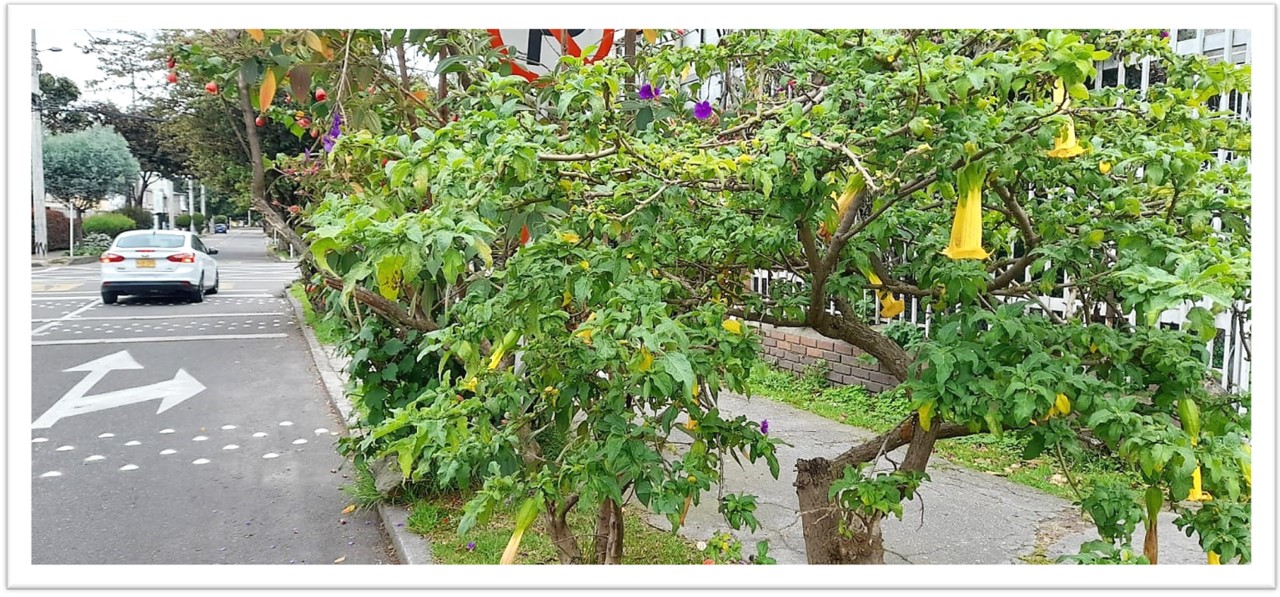
Burundanga: a dope drug for drugging
Burundanga has natural properties that make it ideal from crime: if given correctly, it works fast, leaves the victim very quickly unable to resist, but at the same time mentally alert and appearing normal. At a certain dose renders the victim compliant, and best of all (for the drugger) unable create new memories, an effect called ‘anterograde amnesia’.
You don’t just forget; you never recorded it in the first place. The upside for druggers is that with scopolamine the victim is less likely to recall details of what happened during those missing hours or days, in contrast to other “date rape” drugs where memories can be partially recovered.
Another plus for the gangs is – if they get the dosage correct – the victim will willingly collaborate, give over bank card pin numbers, even got themselves and withdraw cash from an ATM, let gang members into his/her apartment or hotel, and even persuade the receptionist or guard these are ´friends´. In other cases, victims have been persuaded to sign house deeds, smuggle cocaine on flights and of course submit to sexual predation.
On top of that it is very hard to detect burundanga as it breaks down fast in the human body (within hours) destroying the evidence.
Burundanga is scopolamine extracted from the brugmansia plant, a shrubby relative of the datura plants, used for traditional medicine, witchcraft and rituals (and drugging) on all continents since time immemorial. What makes Colombian burundanga special is that brugmansia – there are several varieties – have been intensively grown by indigenous people and used by shamans for millennia, being raised like prize tomatoes to see which gives the best hit.
According to distinguished ethnobotanist Richard Schultes, South American brugmansia species result from human cultivation and perfectionism. Varieties variously known as borrachero, campanilla, maicoa, floripondia, huanto, toe, and tonga, and are stronger that Old World datura relatives.
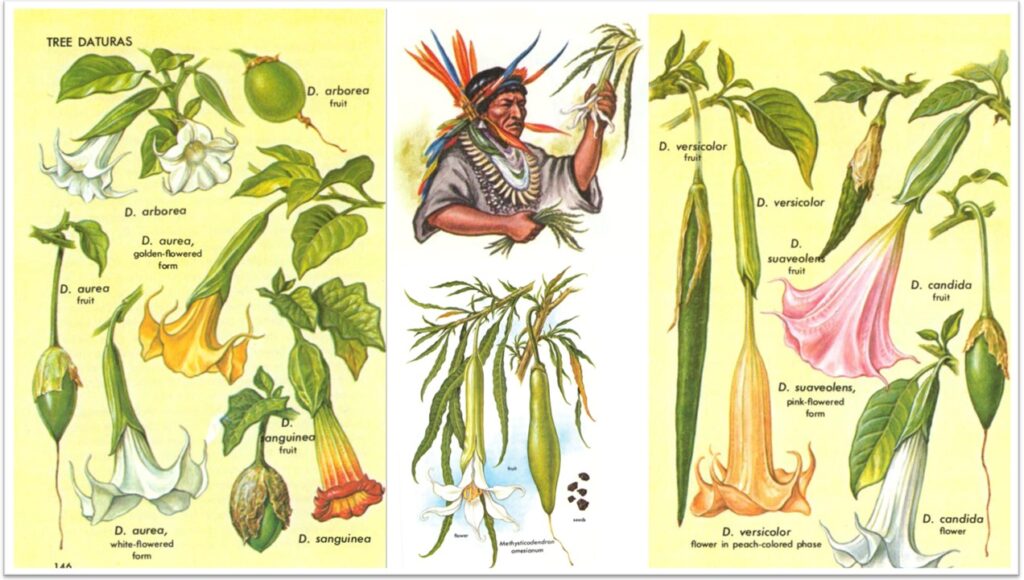
Even in small doses, Colombian scopolamine can cause excitement, hallucinations, and delirium. The trees are the special property of certain medicine men who employ the drug in difficult cases of disease diagnosis, divination, prophecy, or witchcraft.
Today brugmansia are commonly known as Angel’s Trumpets (for their conical flowers) and are often kept as ornamentals with trade names such as ‘Inca’s Sun’ in the U.S., Europe, Australia and New Zealand, where they have gone wild and been declared an invasive species. Growers are warned they might poison dogs and cats.
From angels to the underworld
Brugmansia is the pretty plant that make a twisted molecule. Getting burundanga from the Angel Trumpet requires processing the parts – usually the seed pods – with chemicals such as acetone – similar to producing cocaine – to make an odourless white powder that can kill with just a few grams, and render a large adult unconcious with just miligrams. It’s its high potency and clumsy dosing (tipping some in someones drink) that makes burundanga hard to handle.
There’s some on-line evidence from the druggers themselves that they try to give their victims a small dose intitially to see how they react, and up the dosage as needed.

According to gang leader Cobra, interviewed by Obi Laand on Youtube, his team of druggers (he has around 30) use scopolamine he calls “Seven Hells” sourced from plants via contacts in the Amazon (possibly shamans in on the act). The burundanga is processed in Medellin before being mixed it with pharmaceutical drugs, probably sedatives such as benzodiazepines.
Why the mixture? As we’ve seen, burundanga can create delirium and aggression (as in my own drugging case) and the sedatives are needed to create a balance. The professional druggers are trying to reach the sweet spot where their victims are mobile, alert and compliant – and not appearing drugged – and not going batshit crazy with delirium and hallucinations or falling stone asleep, or worse, dead.
Colombian cocaine criminals learned long that killing to many people (particularly foreigners) brings unwanted police attention. Drug gangs follow the same edict: keep the body count low.
So how not to kill your target? That’s a problem for the druggers – and a bigger one for the victims – as mistakes happen, maybe too much powder got tipped in the drink, and who knows what other drinks or drugs the victim took and what underlying health condition they might have – hypertension or a dodgy ticker – that puts them under for good.
Marking the target
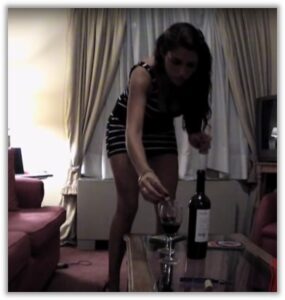
Still with me? Good.
Cobra gives some insights on how victims are targeted in Medellin: the gang hangs out in bars and watches closely to see who is spending big, carrying cash or a large numbers of cards, who is drinking, how many in the group.
The gang consists of trained druggers, mostly attractive young chicas, accompanied by professional ‘markers’ who spot potential victims and alert the drugger, and a team of transporters (often taxi drivers on the payroll) who help manipulate the victims and, if required, transport valuables or even clear out apartments.
Once identified, the mark is approached by the drugger who will flirt and try to administer an initial dose of burundanga followed up my stronger doses or sedatives. According to Cobra, his gangs targets Afro-American tourists because “they like the Latina girls” , and carry cash, cards, watches and jewlery.
Druggers are trained to deliver an initial dose through a variety of methods: food, drinks, cigarettes. At some point the chica brings over a friend – druggers usually work in pairs – and then persuades the now willing victim to go back to his hotel room or flat. The taxi waiting outside is part of the plot.
Of course, many drugging victims willingly invite their attackers back to their flat even before they are drugged, as a sting video (from Argentina) demonstrates, and could have even met them in their flat in the case of Tinder dates or transactional sex workers. In these cases, the drugger is already home and can drop drugs into the drink when the host is not looking or has gone to the bathroom.
A whiff of the Devil’s Breath

So that’s the classic boy-meets-girl(s) drugging scenario, but there are plenty of others, such as the woman in Medellin last year drugged when she stopped to help two elderly women asking directions to a pharmacy written on a prescription which she held close to her face to read close up….she woke several hours later. CCTV of her missing hours showed her accompanying the women to her own apartment which they then proceeded to empty.
Other victims have been drugged on buses, in libraries, taxis, restaurants and supposedly during a Spanish lesson (we don’t have any details on that one, but can assume they were learning the verb desmayar).
So is it true that burundanga is so strong you can take a whiff and pass out?
Many scientists doubt that, but Cobra claims his Amazon-sourced Seven Hells (and I mean the Amazon jungle, not Jeff Bezos’s outfit) is so strong “it can knock down an elephant”.
Some female druggers describe rubbing it on their own face – after blocking their own nostrils with cotton wool – before smooching with their targeted victim who leans in for a kiss and…adios. And it’s worth noting Quis’s story, linked above, when a bar chica suspiciously rubbed a lotion on his top lip. To his credit, he reacted immediately by cleaning his mouth with his drink, then washing his face and dislodging any poison. Such fast reactions are rare: you probably have only seconds to think and act.
The other debate is whether burundanga can be absorbed through the skin, for example when holding a business card or leaflet someone gave you on the street. Unlikely, say scientists, it would take too long for a reaction. What is probably happening in these cases is that the druggers are coating the paper or card with very fine burundanga powder which the victim then inhales. In the case of the taxis with poisoned handgel, probably the marks rubbed their hands then smelt them (which we all did during covid, right?).
Good Night, Cinderella
Pharmaceutical sedatives such as the benzos (Zanax, Valium, Halcion) are slower acting than burundanga but easier to handle (less risk to the drugger) and easy to buy over the counter in Colombia from numerous backstreet pharmacies.
I once asked for “a pill to help me sleep” at the pharmacy in airport in Bogotá – it was before a long flight – and was immediately handed a packet of zopiclone, a controlled drug, no questions asked. “Take one and you’ll sleep for 12 hours,” the farmaceuta said. “Take two and you might not wake up.”
As Cobra explained, sedatives are mixed with burundanga to level out the scopolamine effects, but there it is likely that much drugging takes place just with sedatives, particularly in cases where the drugger already has access to the apartment or hotel room, as in the case where the victim willingly invites them home.
This type of drugging is so common in Brazil it’s commonly called Boa Noite, Cinderella, (Good Night, Cinderella) after a popular soap opera and in the 1990s I came across several cases in Rio hotels.
As mentioned above, two recent deaths of tourists in Medellin were linked to benzodiazepine and clonazepam creating commentary many ‘burundanga’ drugging events are solely benzos.
The scopolamine clock is ticking
One scientific study suggests that benzos are more widely used than scopolamine in Colombia: the Colombian Neurological Association (CAN) analyzed 860 patients hospitalized for ‘scopolamine poisoning´, in fact 44% victims had benzos in their system, and only 12% turned up scopolamine traces.
But as we’ve seen above, this data might be skewed by forensics: benzos can last days in urine samples whereas scopolamine is undetectable within hours, leaving forensic researchers chasing to “beat the scopolamine clock”.
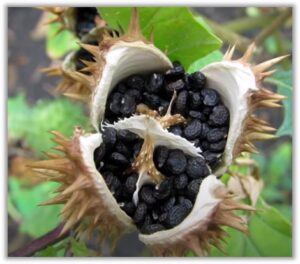
Cobra’s Youtube testimony suggests that in 2023, natural burundanga is still widely used – and routinely mixed with other sedatives – on the streets of Cali, Cartagena and Medellin, and as Vice reveal in their 2012 documentary, it is relatively easy to buy burundanga powder in the Bogotá underworld.
It’s probable that several classes of drugs are used, depending on by whom and the target: Tinder dates might be happy to use benzos or other sedatives to put the mark to sleep in his own apartment, then steal any valuables.
More organized gangs may prefer scopolamine to create a compliant state whereby the victim hands over PIN numbers or bank account details or collaborates in emptying their own flat. In the latter case they also use benzos to control any delirium.
Being slower acting doesn’t make benzo sedatives safer: these drugs shut down your central nervous system and an overdose can stop you breathing, and they are particularly dangerous when mixed with alcohol or opioids, which many victims might be using.
Night of the Living Drugged
One supposed aspect of burundanga is its ability to render its victims into an auto-suggestive state, otherwise described as “being led around like a zombie”.

This concept of chemical submission was mooted by ethnobotanist Richard Schultes in his 1970s book The Golden Guide to Hallucinogenic Plants where he recounts use of burundanga by South American tribes: apart from ritualistic hallucinogens, the seed pods were also used in Colombia by the Chibchas to prepare mixtures to “induce stupor in the wives and slaves of dead warriors and chieftains before they were buried alive to accompany husbands and masters on the last trip”.
Burundanga is still widely used by South American shamans where it is revered as the most powerful ingredient in their arsenal of tropical plants, Brugmansia is taken rarely, usually alone and only by the patient in extreme circumstances, such as a fascinating case study of a Peruvian indigenous man who broke his back in a fall from a tree and was helped to survive with long-term doses of burundanga.
Western researchers today class scopolamine as a deliriant. Many point out it’s the least studied class of hallucinogen when it comes to its effects and neurological impacts. This leaves a lot of gaps in the scientific literature, and considerable debate over whether victims can really become so compliant – or if they were in on the plan all along.
This Guardian article Dupes, Not Dopes, from 1999, for example, pours cold water on the ‘I was brain-washed by burundanga’ defense used in some high-profile cases, such as a Chilean diplomat caught smuggling cocaine.
Urban myth or real world?
According to the Guardian article, toxicologists and psychologists who have investigated the effects of scopolamine play down the brainwashing effects which are ‘better understood in terms of disinhibition which causes people to act in ways that they later regret’.
Other academics claim that burundangas effects on a victim’s free will are ‘urban myth’.
More recent research from the University of Barcelona supports the fact that scopolamine victims lose their ‘memory acquisition’, but the brainwashing claims are harder to prove in the laboratory. But the report also acknowledges that real world victims drugged in bars ‘are under the influence of other drugs’, and more research is needed.

Have Colombian gangs perfected drugging techniques that have so far eluded the world’s scientists? Quite likely.
One thing that sets criminality apart in Colombia is the expertise of organized crime gangs and their willingness to experiment, diversify, and control markets and up profits using advanced business models. This stems largely from the huge profits and opportunities from cocaine trafficking and a state of weak institutions that rewards rule-breaking. Technically, the drugging gangs are ahead of law enforcement and the scientists and, unfettered by moral qualms, can experiment with drug combinations to rob people.
Another factor is that scientists are likely studying medical scopolamine, used in low-dose patches to prevent seasickness, to prevent nausea, or a pre or post-surgery sedative. Can this compare to plant-derived burundanga? The natural product has other deliriant chemicals such as atropine and hyoscyamine, and has been custom-cultivated by shamans for centuries to create weird effects. Who knows what else is in Cobra’s Seven Hells?
Caught on Camera
A recurring theme of burundanga is victims willingly handing over bank card PINs, bank account details (to assist with transfers) or provide facial recognition. In the case of the U.S. soldiers drugged, kidnapped and robbed in 2020, the perps (now facing trial in Miami) admitted they used a cellphone to imitate a card reader and the victim willingly entered the digits which they then used with the cards in ATMS to withdraw cash.
In other cases victims appear to collaborate with their aggressors, visiting the bank or ATM themselves, or even accompanying the gang back to their own flat, in some cases caught on CCTV even persuading the doorman of the building or hotel to let them in.
In these cases it seems the victim is constantly accompanied by the aggressors, suggesting the ‘auto-suggestion’ only works with someone telling the victim what to do, and perhaps to administer more doses of the drug.
In the infamous Chilean case from the 1990s – when a well-known diplomat vanished for three days only to reappear at Santiago airport with a suitcase full of cocaine – he was in the company of a woman he didn’t know, and probably giving him instructions.
The fact that burundanga victims need to be escorted suggests scientists are partly correct: the drug does not brainwash, but rather creates a suggestible state where victims must be prompted.
So maybe Burundangueros cannot be ‘programmed’ like a clockwork mouse and set loose on a solo mission. That’s some good news.
Drugged and drained
For most drugging victims it’s an overnight experience: their attackers quickly abscond with the loot and the burundanguero awakes next day trying to figure out what happened. And where’s my phone?
But frequently, victims only appear several days later. One Friday in April 2022, student Juan Lopez mysteriously disappeared while walking a few blocks from the University Javeriana, the CCTV then tracked him to the forest on the hills above Bogotá where he was found three days later in the city center wandering naked, barefoot and seemingly drugged. Police found that his bus pass had been used in the intervening days, although it is unclear who attacked him or why.
That same night in Bogotá, Hernan Mejia was last seen leaving a restaurant in Chapinero – La Mesa Franca – by taxi and turned up dead three days later. In March 2023 a young woman from Medellin was found three days later…hospitalised in Cali.
Long-term disappearances have two causes. One, the victim has been dropped off somewhere, is still under the effects of the drug and is wandering around confused. Unfortunately Colombia has a large down-and-out population means a burundanga victim can easily fit in with the background vagrancy of major cities.
Hospitalized victims have usually lost their phone and ID. It takes time for the authorities to identify them and connect them to their families or friends.
But there are clearly cases where drugging victims are held by the criminal gang for several days, in order to fully drain their bank accounts. This happened to Eric Hall who was drugged and held for three days against his will in Medellin. He has no recall of the missing days and awoke in an empty flat in a state of confusion. Bank statements show bank account was drained of US$6,800 with transactions from his cards used in local shops and app transfers.
The druggers needed Hall present for three days because they needed his approval on bank card transactions while they bled his account, the Californian says in his Youtube testimony, and this required more doses of scopolamine – ‘every 12 hours’ – to keep him compliant. And, as Hall points out, continuous dosing ‘ups the chances you can die’.
Don’t bank on the banks…

One frustration for Hall, as with other victims such as long-term expat Kevin McCaffrey who lost US$15,000 from his Colombian account, is that banks don’t always automatically recognize drugging as a fraud that can be reimbursed.
This is because the victim often supplies the PIN number and other passwords to his/her attackers, and in their drugged state can also provide facial or fingerprint verification of transactions. Somewhere in the small print when you opened your account is your acknowledgement that if you ‘willingly’ gave access to your account they won’t pay you back.
But in cases in the UK banks have refunded the victim – usually after media attention. In some U.S. drugging cases, banks have also paid up.
There’s no guarantee, though, that victims whose bank transaction were made overseas – particularly in Colombia, or from Colombian banks – will have such luck.

Obviously, it pays to prevent the payments in the first place and, as Eric Hall points out, to reduce the risk of being kidnapped for several days with repeating drugging doses.
Ironically the security measures brought in by most banks and which they insist are operated through our cellphone apps – face recognition, fingerprint access, rolling passcodes – make us less safe since they’re a reason for drug gangs to keep us captive if they think they can keep draining our accounts. Note that facial recognition can work with your eyes closed.
How to keep your bank accounts safe? When travelling, keep minimum amounts in current accounts, or carry pre-paid debit cards, and leave your savings locked into less accessible accounts which need your physical presence in the bank to unlock (in Colombia these are called CDTs). Make sure your phone banking app only shows one account with a low balance.
Or carry cash. This might sound counterintuitive, but many travellers and expats (me included) feel safer going out drinking only carrying the folding stuff. Apart from controlling your expenses (you can’t spend what you don’t have!) if you are drugged, the attackers will give you the minimum dose and make off with your wad. Obviously don’t make yourself more of a target by flashing a large roll of notes every time you buy a beer…
The doctor will see you now…

Burundanga poisoning is a form of Anticholinergic Syndrome, often reported as accidental (or experimental) ingestion of the brugmansia plants or seed pods. Hospital medics learn the following ditty to diagnose patients: ‘hot as a hare, red as a beet, dry as a bone, blind as a bat, full as a flask and mad as a hatter’ which relates to symptoms of fever, flushed skin, dry mouth and skin, dilated pupils, urinary retention and crazy behaviour (delirium). Serious symptoms include seizures, coma, and heart failure leading to death.
Delirium can present as restlessness, fidgeting, violent acts (some patients need to be restrained), visual hallucinations, picking at imaginary objects in the air or on the bedsheets, mumbling or slurred speech and fluctuating mental status. Delirium can persist for days following a big dose.
Survivors can experience mental and social side-effects that may need psychological treatment. These include loss of attention span and reduced concentration, forgetfulness, anxiety and withdrawal.
And get this: severe cases are treated with benzodiazepines – the same drug that the drug gangs are often mixing with scopolamine to level out the effects.
Many victims do wake up in a hospital bed in Colombia – which is a least-worst outcome – where medics are experienced in treating drugging victims. In this case you will be treated and tested under emergency health framework – initially for free, though this may depend on what hospital you landed in.
Patients with any suspicion of suffering sexual attack (male or female) should – in theory – get Post Exposure Prophylaxis (‘PEP’) treatment which tests and cures (or prevents) sexually transmitted diseases and HIV-AIDS. Rape victims especially need this to happen fast (within 72 hours of the attack) as drugs can be given within this window to stop any HIV infection. The actual drugging victim may be too disorientated to insist on this, but if you are supporting a friend or family in hospital do ask the doctors.
Nowadays in Colombia, Post Exposure Prophylaxis should be given immediately and without question to sexual attack victims – and not dependent on any ´crime report´ – but don’t always count on every health center to do this (the larger hospitals in large cities are a better bet). Push for PEP, and if necessary, find a private clinic or doctor to get it done…
The US Embassy has a list of recommended clinics and hospitals for emergency attention.
Testing, Testing
Fast and cheaper scopolamine rapid tests have hit the markets in the US and Europe in last six months with test sticks for scopolamine (saliva or urine) which claim to show results in 15 minutes, they also pick up MDPV (monkey dust) a drug used for spiking in Europe. .

Whether these rapid tests are a breakthrough for the medical and legal aspects for drugging is yet to be seen; certainly the previous tests were complicated and expensive, so a cheap rapid test could be useful, particularly the nicely named NarcoCheck Scopolamine Urine Test at US$7 a shot. Some strip tests being developed can detect scopolamine in your drink.
it’s interesting that these rapid tests are now being produced overseas, and might reflect a growing problem with burundanga in Europe and the US. For years now thre have been home test kits for drugs like GBH, katamine and benzos such as TestMy Drink or Drinks Detective.
In fact some of these home drug test kits are available on-line in Colombia, but so far I’ve not found the scopolamine ones here; maybe because of a lengthy approval process for new drugs and test with the Colombian medical authorisation agency (INVIMA) .
However, if you can buy them abroad there would be no problem to bring in a few test sticks in your personal luggage for personal use, so might be an option for people wanting their own way to check if they were drugged, and with what. The NarcoCheck claims to work up to three days after exposure to scopolamine, which would be useful.
The rapid tests for your drink could be useful too, and having a packet handy to check your beer every 15 minutes could deter a drugging attempt (but also make for a slow evening) . I’m sure these rapid tests will be available in Colombia in the future, so watch this space.
Law and disorder
Don’t expect much help from the local cops if you were just drugged and robbed, as many victims recount; police are indifferent or possibly complicit.
Colombia has a long history of corruption and collusion in the security forces, and even when criminal gangs are ‘taken down’ it’s usually only low-level gang members (or the bar chicas who are themselves victims of coercion and exploitation) being paraded before the TV cameras.
An illustrative tale is told by Tobias the Traveller, who was drugged by two women in his Medellin apartment. The doorman of his apartment complex refused to let the women out of the building at 4.30am and called the police.
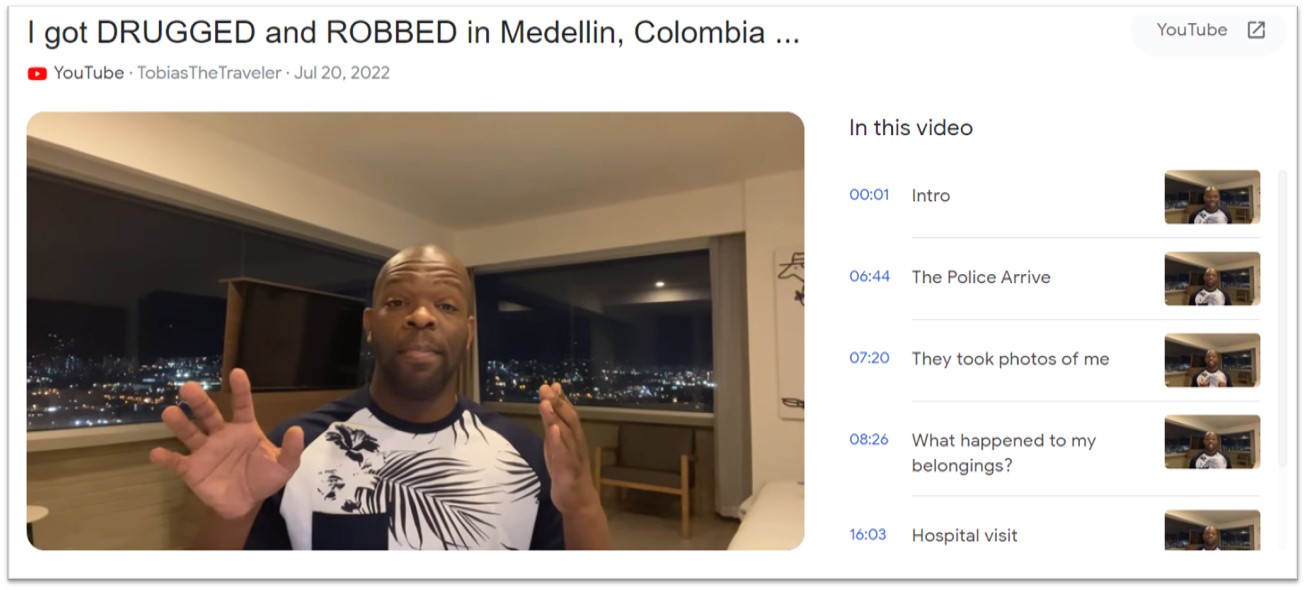
The police searched the two women, found Tobias’s valuables on them (credit cards, watches, phones, computer etc), let the women go and kept the laptop and the cash as confirmed by his attackers themselves (they messaged him the next day!). The chicas were sharks, but “law enforcement are the larger sharks,” muses Tobias.
The local police response is in stark contrast to some high-profile cases – or drugging deaths – where the authorities investigate with the Fiscalía (Attorney General’s Office) using specialist teams such as the CTI (forensic experts of the Cuerpo Técnico de Investigación), the DIJIN (Dirección de Investigación Criminal e INTERPOL de la Policía Nacional) and, in cases of kidnapping or disappearance, the GAULA (Grupos de Acción Unificada por la Libertad Personal).
Denounce the crime…and tell your embassy
Once on the case, these elite Colombian teams usually get results. Though often they only swing into action when the family causes a ruckus, or a foreign embassy breathes down their neck.
In the sad case of Paul Nguyen, who was drugged and died in Medellin in 2022, the victim had sent out a Snaphcat photo of his Tinder date attacker just before he was drugged. But even with this evidence, according to a Vice article, the Medellin police were slow to open an investigation so the family hired private investigators – Wyn Medellin – to speed up the process.

If you are in imminent danger, you should immediately contact local authorities by dialing “123” from any Colombian telephone for police and emergency services anywhere in Colombia.
If you are drugged, robbed, and recovered then denouncing the crime should be initially done at the local police station, but they will likely refer you to the Fiscalía where you can make a denuncia virtual via their web-page. There are three relevant options , hurto (robbery) estafa (fraud, in case of credit card use) and violencia basada en genero (sexual attack).
You can also make an presential report to the Fiscalía at their key centers (often called ´URIs´), to find the nearest to you, consult their interactive map and key in your location data.
Of course, the above tools require knowledge of Spanish so you might need help (but perhaps best not to ask your Tinder date!).
Some embassies ask to be informed of violent incidents, though don’t promise to respond. The US Embassy manages a Victims of Crime in Colombia website with useful data and you can send crime reports (in English) to acsbogota@state.gov.
For British nationals there is a phone number for urgent consular help: +57 601 326 8300, selecting the option for consular services.
Check with your own embassy in Colombia what services are to hand in emergencies; in severe cases they might help up front, or at least push the local authorities behind the scenes to take action.

Busted… and a free flight to Miami!
Successful gang busts have followed their targeting of U.S. embassy and security personnel, such as the dismantling of the Los Canarios taxi gang that robbed passengers (´The Canaries, for their yellow taxis) and stabbed a DEA agent to death in 2013 in one such attack. Seven of the gang were extradited to the U.S.

Justice was done, but only after the large gang (which included a police officer) had operated robbing passengers (the notorious Paseo Millionario) unchecked for a decade in the capital.
More recently in 2023 a gang leader known as ‘Harry Potter’ of the Los Tomaseros made headlines for being extradited to Florida after drugging, kidnapping and robbing two US soldiers in a bar in the upmarket Zona T district of Bogotá back in 2020.
The gang seems to have been operating many years without much legal heat, and even drugged and killed the sister of a senior official, before they were picked up.
The US FBI could collaborate with the crime in Colombia because the two victims were from the US although the crimes were committed Colombia. That precedent could be a deterrent for Colombian drugging gangs who would not want to face justice in the US which is much stricter (and the jails much stronger) than in Colombia. But don’t hold your breath for the FBI to investigate your case…
How not to get drugged and robbed (or worse)
If you’ve made it this far, well done. Now for some practical advice:
- Avoid sex tourist area (mostly in Medellin and Cartagena) and infamous bars where foreigners congregate to pick up women (ask other travellers and hotel staff for latest info in your area).
- Avoid ‘gringo parties’ and ‘gringo nights’, these are often magnets for druggers.
- Use dating apps with great caution and choose neutral public spaces for first encounters.
- Go out at night with a buddy or some friends to watch your back.
- Never accept food, drinks or cigarettes from strangers.
- Buy drinks you can open yourself (beers, mixer cans Keep your alcohol and drug consumption to the minimum to have fun). Always watch your drink.
- Carry cash rather than cards, but keep it hidden.
- If you do use cards, use one debit with low account balance, or pre-paid card.
- Avoid flashy watches or jewelry.
- Consider leaving your phone at home (like the old days).
- Take platform taxis (Uber, Cabify).
- On the street, be wary of people asking directions or trying to give you a leaflet. Politely decline (no gracias).
- Never accept food, drinks or cigarettes from strangers.
- Avoid overfriendly strangers, particularly those in pairs.
- If you think you’ve been targeted, try and find your friends to let them know. If you’re alone head for a populated area so you’re not as vulnerable.
- If someone rubs something on your face, head to the bathroom and wash it off.
- Don’t invite new friends back to your flat of hotel room…it’s a trap.
- If your hotel or flat building has a reception, pre-inform the doorman (put it in writing) that under no circumstances should visitors be allowed back with you (call police in this event).
- If you do have a date, use a separate hotel to where you live or stay. Make you’re your date registers their ID (known as a cedula in Colombia) with the reception.

If you are drugged…
- Symptoms to watch for are nausea, dizziness, drowsiness, blurred vision, fast heartbeat, headaches and poor coordination.
- If you feel these, find a trusted friend, and immediately go home. Do not let anyone else accompany you or tell you which taxi to get into
- If you are in imminent danger, or assisting another victim, contact emergency services on 123 from any Colombian telephone line.
- Once you are awake, get emergency help immediately; inform friends and family, or trusted contacts, then the authorities.
- Seek medical help and if the symptoms are severe, go to the hospital. If the drug is still in your system, it will be important for the doctor to understand what you were given and how strong the dosage so that they can treat you. (See The Doctor Will See You Now, above)
- report the incident to the Colombian police and your embassy (see Denounce the crime…and tell the Embassy , above).
Endnote
Burundanga adds to Colombia’s image as a country that’s both beautiful and deadly. A bit like the plant it comes from.
Many travellers come here looking for adventure – and find it. And victims of drugging get over it, chalk it down to experience, and move on; “Hey, I let my guard down. I got ‘got’. That’s life on the road.”
That’s a good attitude. But it doesn’t speak to the mortal drugging victims, or those that suffered physical and sexual abuse, or the Colombian victims whose voices are less heard. Or the collateral victims of the vicious gangs that profit from drugging.
Please share this post (and others like it) to spread the word on burundanga and other forms of drugging. And if you are drugged, or know someone who has been, please denounce to both the Colombian authourities and your embassy or consulate. Keeping track of attacks – even if the cases aren’t immediately resolved – can help in the long run to bring criminals to justice.
Be safe.

